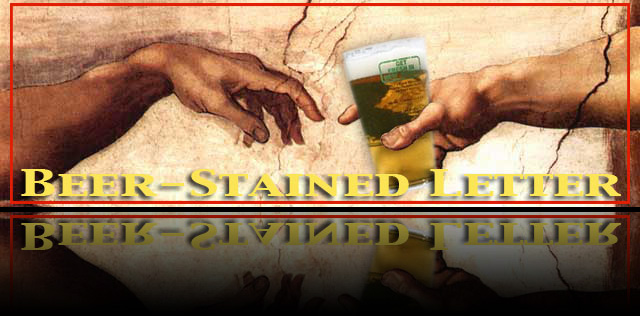Window On The Past
Even the simplest homebrewing setup features a few innocuous -- but still sophisticated -- tools that keep you from brewing by the seat of your pants.
Take the hydrometer, for instance.
This baby tells you when the yeast that feast on your wort have a bellyful and are ready to call it a night, settling on the bottom of your fermenter.
The device looks simple enough -- a weighted glass bulb with a graduated stem. But its sophistication lies in the physics of its job: floating in a cylinder filled with wort, indicating the liquid's density. That, science fans, is called specific gravity. And, specifically, it’s not much of hot conversation topic, but trust us, there’s a point to be made here.
Malt sugar solution is denser than alcohol, so your hydrometer will float higher in wort. (Photo taken at Flying Fish Brewing Co. in Cherry Hill) A week later -- after that big yeast feast -- the hydrometer sinks deeper into the beer, so you’ll see less of the stem (the graduated part you check and record numbers from like 1.052 etc., depending on the units you use). With some simple math, the before and after numbers you read from your hydrometer let you calculate the beer’s alcohol content. Commercial breweries do this (if you’re in Britain, that’s rather important, since alcohol content determines the excise taxes paid on the beer brewed in the UK). Lots of homebrewers take a gravity reading, too, especially ones who journal just about every batch.
And here’s the point (finally!):
Imagine just winging it, not only with specific gravity, but with just about everything in the brewing process: no measuring guides, timers or gauges to say when the water’s hot enough, how long the mash has gone or how long the wort has boiled.  Brewer Rich Wagner does this, walks the high wire without a safety net. Not because he wants to be daring or throw science to the wind. Rich is a beer historian; his niche is Colonial brewing -- you know waistcoats, breeches, tricorn hats, coopered casks and barrels, oak fires and taverns where you caught up on the news of the day (and blew off steam about how you were getting reamed by taxes; some things never change).
Brewer Rich Wagner does this, walks the high wire without a safety net. Not because he wants to be daring or throw science to the wind. Rich is a beer historian; his niche is Colonial brewing -- you know waistcoats, breeches, tricorn hats, coopered casks and barrels, oak fires and taverns where you caught up on the news of the day (and blew off steam about how you were getting reamed by taxes; some things never change).
So if you see Rich decked out in period garb and joined by his wife, Anna, he’s making beer, demonstrating how Samuel Adams (the Samuel Adams, not Jim Koch’s incarnation) would have made a righteous and rebellious batch of ale to fill the tankard. Ditto for Washington, Franklin, William Paterson, Gouverneur Morris, or anyone else who would call the 1700s “back in the day.”
His stomping ground is eastern Pennsylvania, where he takes his act on the road a lot. (Look for him on April 17th at Tria Cafe's Fermentation School in Philadelphia for a talk on the Drinks They Served in Colonial Philadelphia.) We caught up with Rich last fall at the Camden County Historical Society (he returns there in September).
Rich has brewed like a forefather long enough (and perhaps partied like it’s 1799 with the finished product) that much of his technique is on autopilot. Call it more than a decade's worth of experience at the cauldron, and more than two decades of research. But whether he’s checking time by the sun’s position in the sky or eyeballing a measure of homegrown hops and a pour of grain, his methods have been time-tested and have proved worthy. And he swears by the flavor of some of the throwback ales he has made, although he has some advantages -- better yeast, for one -- that Washington (who brewed a porter) would probably have crossed the Delaware all over again for.
The point of Rich's demonstration: Beer's our heritage, a part of what we are.














1 comment:
Sorry if, while I read your account, the homebrew brewing inside the bottomless pit of my bowels is starting to bubble, splutter and erupt, I'm still fascinated by your detailed description. It reminds me of old homebrew and salad days when my auld folks had their homebrew lab bubbling away in the pantry.
I think You need to go on and enjoy a beer pilgrimage - to the beer country of the world, my country, the State of Bavaria in Germany. We have Augustiner Helles and Edelstoff, Salvator and Maximator, Bock and Doppelbock, Weihenstephaner, Andechser and Ayinger.. You name them...
Post a Comment